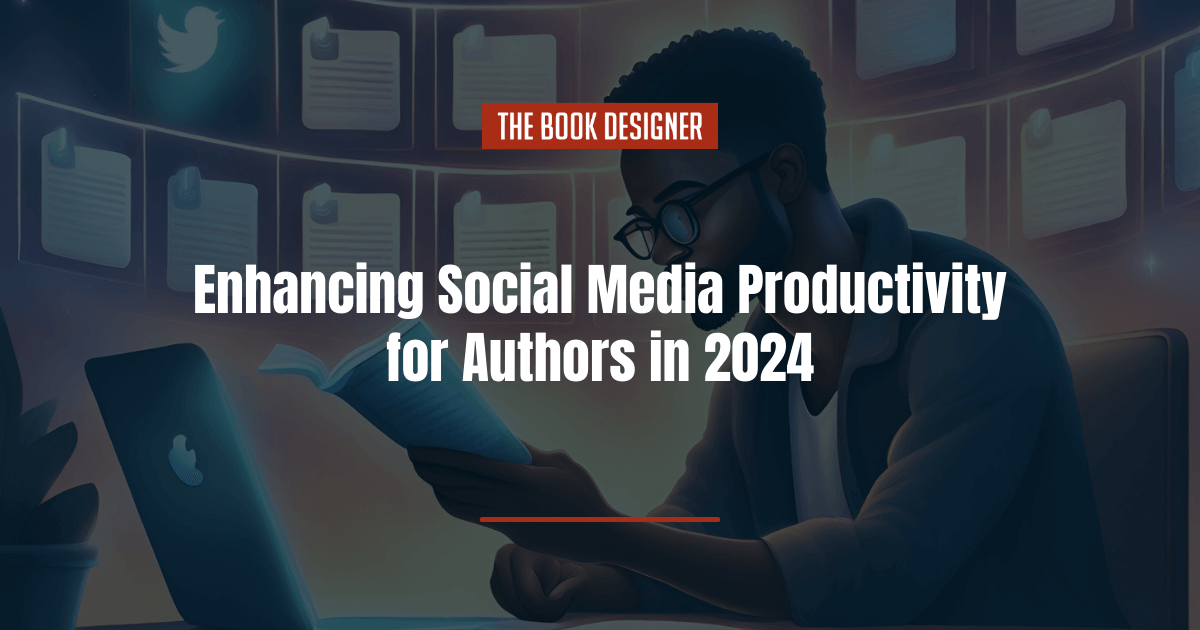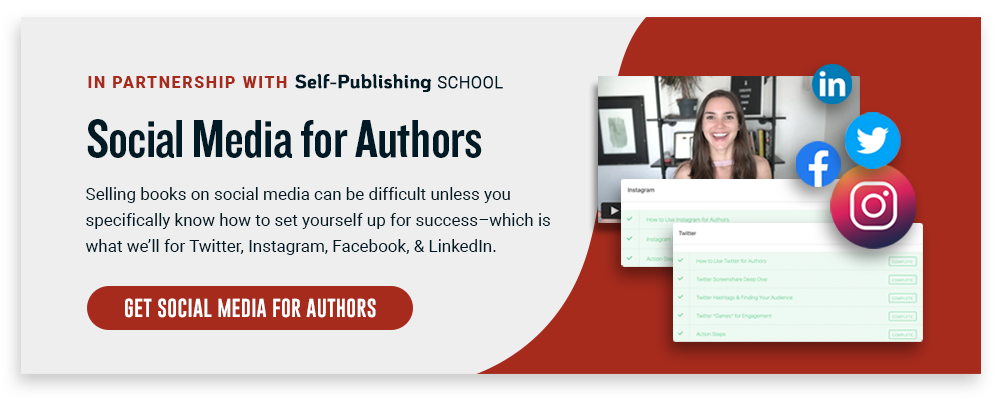In the dynamic world of publishing, where a writer’s dream of bestseller success meets the daunting task of book marketing, harnessing the power of social media is indispensable. The key to balancing writing and marketing effectively lies in productive social media strategies. In 2024, these strategies have evolved with the advent of new platforms and changing user demographics. Let’s explore updated tips for maximizing social media productivity for authors.
The success of an author’s social media strategy greatly hinges on the wise selection of platforms. Understanding the nuances of each platform and aligning them with your audience and content style is crucial for maximizing social media productivity.
Below we’ll cover some tips for better social media productivity for authors:
Choose Your Platforms Wisely
Analyzing Audience Demographics and Platform Popularity
Despite new contenders, Facebook and YouTube remain popular, with 69% and 57% usage respectively among US adults. Facebook’s broad age range appeal and YouTube’s vast reach make them ideal for targeting a diverse audience, including those over 25 years old.
Instagram and TikTok are particularly popular among the younger demographic, aged 18-24. Instagram, with a 45% usage rate, and TikTok’s rapidly growing user base (33%) make them excellent choices for authors aiming to connect with younger readers.
LinkedIn’s 20% growth, particularly among Boomers, positions it well for authors with a more professional or business-oriented audience.
BeReal’s 313% growth in usage and Twitch’s appeal as a live-streaming platform have opened new avenues for authors. BeReal’s focus on authenticity might attract authors aiming for a more personal connection with their readers. Twitch, although traditionally gaming-focused, is branching out and can be an unconventional platform for live readings or discussions.
Platform-Specific Strategies for Authors
Facebook and YouTube are ideal for long-form content and video trailers. Authors can use Facebook groups for reader engagement and YouTube for book trailers and author interviews.
Instagram and TikTok are perfect for visual storytelling and reaching a younger audience. Authors can leverage Instagram for aesthetically pleasing book-related posts and TikTok for short, engaging video content about their writing process or book teasers.
BeReal can be used for sharing behind-the-scenes content from an author’s daily life, offering a genuine peek into their writing journey. Twitch, on the other hand, is great for interactive sessions like live readings, Q&As, or discussing writing tips with an engaged audience.
LinkedIn is effective for networking with other authors, publishers, and industry professionals, and sharing articles or thought leadership content related to writing and publishing. It’s also an excellent platform for nonfiction authors, especially those who write books for the business and professional markets.
Authors need to be strategic about their choice of social media platforms. By aligning their content and audience with the right platforms—from the ever-popular Facebook and YouTube to the rapidly growing Instagram and TikTok, and considering emerging platforms like BeReal, Twitch, and LinkedIn—authors can significantly enhance their social media productivity. The key is to not only be present on these platforms but to use them in ways that resonate with their unique audience and personal brand as an author.
Curate Your Content
In the realm of social media productivity for authors, content curation plays a pivotal role. It’s about striking the right balance between sharing interesting, relevant content from various sources and intertwining it with your original work. Let’s delve deeper into how authors can effectively curate content in 2023.
Understanding the 80/20 Rule for Content
The 80/20 rule, also known as the Pareto Principle, originally referred to the idea that 80% of your results will come from 20% of your effort. It has been applied to many other things, though, including the types of content you share.
80% Curated Content: This involves sharing content from other sources. For authors, this could mean industry news, book reviews, writing tips, literary discussions, or updates about the publishing world. The idea is to provide value to your audience by filtering and presenting content that they would find interesting and informative. It can also include updates from other authors!
20% Original Content: This is content you create, which could include updates about your writing process, excerpts from your work, personal insights into your writing journey, or announcements about your book launches.
Sources for Curated Content
- Literary Blogs and Websites: Websites like Alltop.com are a treasure trove for a wide range of topics, including literature and writing. Authors can also look at specific literary blogs, online magazines, and websites that resonate with their genre or writing style.
- Social Media Platforms: Platforms like Twitter and Reddit are not just for posting; they’re also excellent for discovering trending topics, especially those related to literature, writing, and publishing. Authors can share interesting threads, news, or discussions they find on these platforms.
- Podcasts and Webinars: With the rise of digital media, podcasts and webinars have become rich sources of content. Authors can share episodes or sessions that they find particularly insightful or relevant to their audience.
- Book Clubs and Reader Communities: Online book clubs and reader communities are great for finding out what readers are currently interested in. Sharing content from these sources can help authors stay connected with their reader base.
Best Practices for Content Curation
- Add Your Perspective: When sharing curated content, add a personal comment or insight. This not only shows your engagement but also provides your audience with a reason to pay attention to what you’re sharing.
- Maintain Consistency with Your Brand: Ensure that the curated content aligns with your brand as an author. If you write historical fiction, for example, content related to history, historical research, or even popular historical fiction works would be more relevant.
- Use Scheduling Tools: Leverage tools like Hootsuite or Buffer to schedule curated content. This helps in maintaining a consistent presence on social media without the need to be online constantly.
- Engage with Shared Content: When your audience comments on the curated content you’ve shared, engage with them. This builds a community around your social media presence and encourages more interaction.
Content curation is not just about sharing others’ content but about enriching the reader’s experience with diverse, relevant, and engaging material. By following the 80/20 rule, utilizing varied sources, and engaging with the audience, authors can effectively curate content that complements their original work and fosters a strong connection with their readership.
Schedule Your Posts
In the fast-paced world of social media, authors find themselves juggling content creation with writing, often leading to a compromise in either of the two areas. This is where the strategic scheduling of posts comes into play, offering a balance that is vital for maintaining a consistent online presence without encroaching on valuable writing time.
Scheduling allows authors to plan their content in advance, ensuring a steady stream of posts that keep their audience engaged. By allocating specific time slots for content creation and scheduling, authors can avoid last-minute rushes and the stress of daily posting.
Tools like Hootsuite, Buffer, or even native scheduling options provided by platforms like Facebook and Instagram have become indispensable in this regard. They allow authors to set up posts for days or even weeks ahead, ensuring their social media feeds remain active while they focus on their primary passion—writing.
Tailoring Content to Audience Rhythms
An essential aspect of post scheduling is understanding the best times to post, which varies depending on the platform and the author’s specific audience. Analytics tools provided by social media platforms can offer insights into when followers are most active, allowing authors to schedule their posts for maximum visibility and engagement.
For instance, posts scheduled during peak activity hours can lead to higher engagement, increasing the likelihood of the content being shared and commented on. This targeted approach not only amplifies the reach of an author’s content but also fosters a deeper connection with the audience, as posts are more likely to be seen and interacted with.
Moreover, authors can align their content with relevant events, such as book launches, literary festivals, or national holidays, scheduling posts in advance to coincide with these occasions for heightened relevance and engagement.
Streamlining the Content Calendar
Scheduling posts also aid in maintaining a diverse and balanced content calendar. Authors can plan a mix of content types—from book excerpts, writing tips, personal anecdotes, to curated literary news or reader-generated content—and schedule them to ensure a varied and interesting feed. This methodical approach prevents content from being too monotonous or sales-oriented, a common pitfall in author marketing.
Regularly scheduled content helps in building anticipation among followers, especially if it’s aligned with ongoing or upcoming projects, like a book release countdown or a weekly feature like “Writing Tip Wednesdays”. Additionally, by looking at the content calendar as a whole, authors can identify gaps or over-reliance on certain types of posts, allowing for a more strategic and well-rounded social media presence.
Engage Authentically
Authentic engagement on social media is a cornerstone for authors looking to build a dedicated following and enhance their brand. With the evolution of social media dynamics, engaging authentically requires more than just responding to comments or likes. Let’s explore how authors can deepen their engagement and truly connect with their audience.
Building Genuine Connections
- Start Conversations: Don’t just wait for your followers to initiate. Pose questions related to your genre, writing process, or literary interests to spark discussions. This can lead to meaningful interactions and give you insights into your audience’s preferences.
- Respond Thoughtfully: When followers comment on your posts, take the time to provide thoughtful responses. Personalized engagement shows that you value their input and are interested in what they have to say.
- Share Behind-the-Scenes Content: Give your audience a glimpse into your life as an author. This might include sharing your writing routine, the challenges you face, or the joys of your writing journey. Such transparency fosters a deeper connection.
Leveraging Different Platforms for Engagement
- Instagram and TikTok: Use these platforms for visual storytelling. Host live Q&A sessions, share stories about your writing process, or create short videos that give insights into your daily life as an author.
- Twitter/X: Participate in trending literary hashtags, join writing-related conversations, and connect with other authors and readers. Twitter chats can be a great way to engage in real-time discussions.
- LinkedIn: For a more professional engagement, share articles you’ve written, comment on industry news, and interact with other writers and publishing professionals.
- Facebook Groups and Pages: Create or join groups that align with your genre or interests. These can be excellent spaces for deep discussions and community building. Recently, it appears that Groups get more interaction and engagement than Pages.
Encouraging User-Generated Content
- Hold Contests and Challenges: Encourage your followers to create content related to your books or the writing process. This could be fan art, story ideas, or writing challenges.
- Feature Fan Content: Share and celebrate content created by your fans. This not only shows appreciation but also encourages others to engage creatively with your work.
Staying Active and Consistent
- Regular Updates: Keep your followers informed with regular updates about your work and any upcoming events or releases.
- Consistent Online Presence: Regularly check your social media accounts to respond to comments and messages. This consistent presence helps in building trust and reliability among your audience.
Engaging authentically for authors is about creating a community around their work. It involves starting conversations, sharing personal insights, leveraging different platforms appropriately, encouraging user-generated content, and maintaining a consistent presence. Through genuine and thoughtful engagement, authors can build a loyal and engaged following, crucial for their success in the digital age.
Incorporate Current Trends
Staying abreast of and incorporating current social media trends is crucial for authors aiming to enhance their social media productivity in 2023. These trends not only offer fresh ways to engage with audiences but also provide opportunities to stand out in a crowded digital space. Let’s explore how authors can effectively leverage these trends.
Embrace Short-Form Video Content
- TikTok and Instagram Reels: With the rise of platforms like TikTok and Instagram, short-form video content has become immensely popular. Authors can use these platforms to create engaging, bite-sized content that could range from book teasers and author introductions to quick writing tips or day-in-the-life videos.
- Storytelling Through Video: Use short-form videos to tell stories, whether it’s about the plot of your book, the inspiration behind your characters, or interesting historical facts related to your genre.
- Participate in Challenges: Engage with your audience by participating in popular challenges or creating your own, related to reading or writing.
Utilize AI-Enhanced Content Creation
Tools like ChatGPT and MidJourney can assist authors in generating creative content, from promotional text to imaginative visuals for book covers or social media posts.
Use AI tools for personalized responses to comments and messages, making engagement more efficient while maintaining a personal touch. You can use writing samples to train AI tools like ChatGPT 4 to write in your voice, which makes this type of content generation more useful for authors.
Engage in Proactive Audience Engagement
- Direct Conversations: Reach out to followers who show interest in your genre or work. Start conversations about their interests, and subtly introduce them to your books.
- Polls and Surveys: Use social media features to conduct polls and surveys. This not only engages your audience but also provides valuable feedback and ideas for future content or books.
Focus on Authenticity and Community Building
- Authenticity Over Perfection: Social media users increasingly value authenticity over curated perfection. Share genuine moments of your writing life, challenges you face, and successes you celebrate.
- Build a Community: Use your social media presence to create a community around your genre or books. Host virtual book clubs, author Q&A sessions, and writing workshops.
Keep Up with Platform-Specific Features
Regularly explore new features on your chosen platforms. For example, Instagram’s evolving focus on Reels and Facebook’s renewed emphasis on community building through short-form vertical videos are trends to capitalize on.
Utilize interactive features like Instagram’s “Ask a Question” or Twitter’s poll feature to engage with your audience in a fun and interactive way.
Integrating current social media trends into their strategy is essential for authors seeking to enhance their visibility and engagement. By embracing short-form video content, utilizing AI for content creation, engaging proactively with the audience, focusing on authenticity, and staying updated with platform-specific features, authors can effectively increase their social media productivity while building a strong and engaged readership.
Final Thoughts
Social media productivity for authors is about making strategic choices. By selecting the right platforms, balancing curated and original content, scheduling posts effectively, engaging with the audience, and incorporating current trends like short-form video and AI-enhanced content, authors can maximize their online presence while efficiently managing their time. Remember, the goal is to build a loyal readership and market your books effectively without letting social media marketing overwhelm your writing schedule.
Editor’s Note: This post was originally written by Frances Caballo in 2017 and has been updated and rewritten by The Book Designer editorial team.




